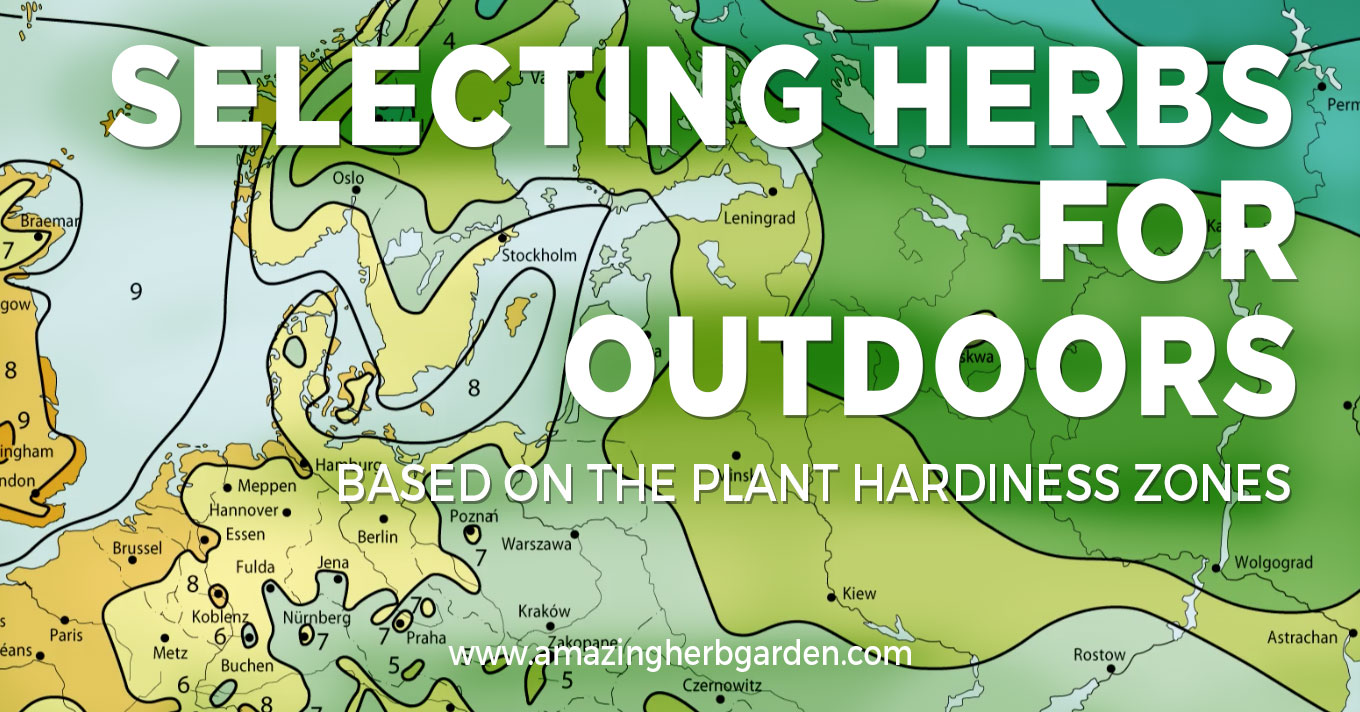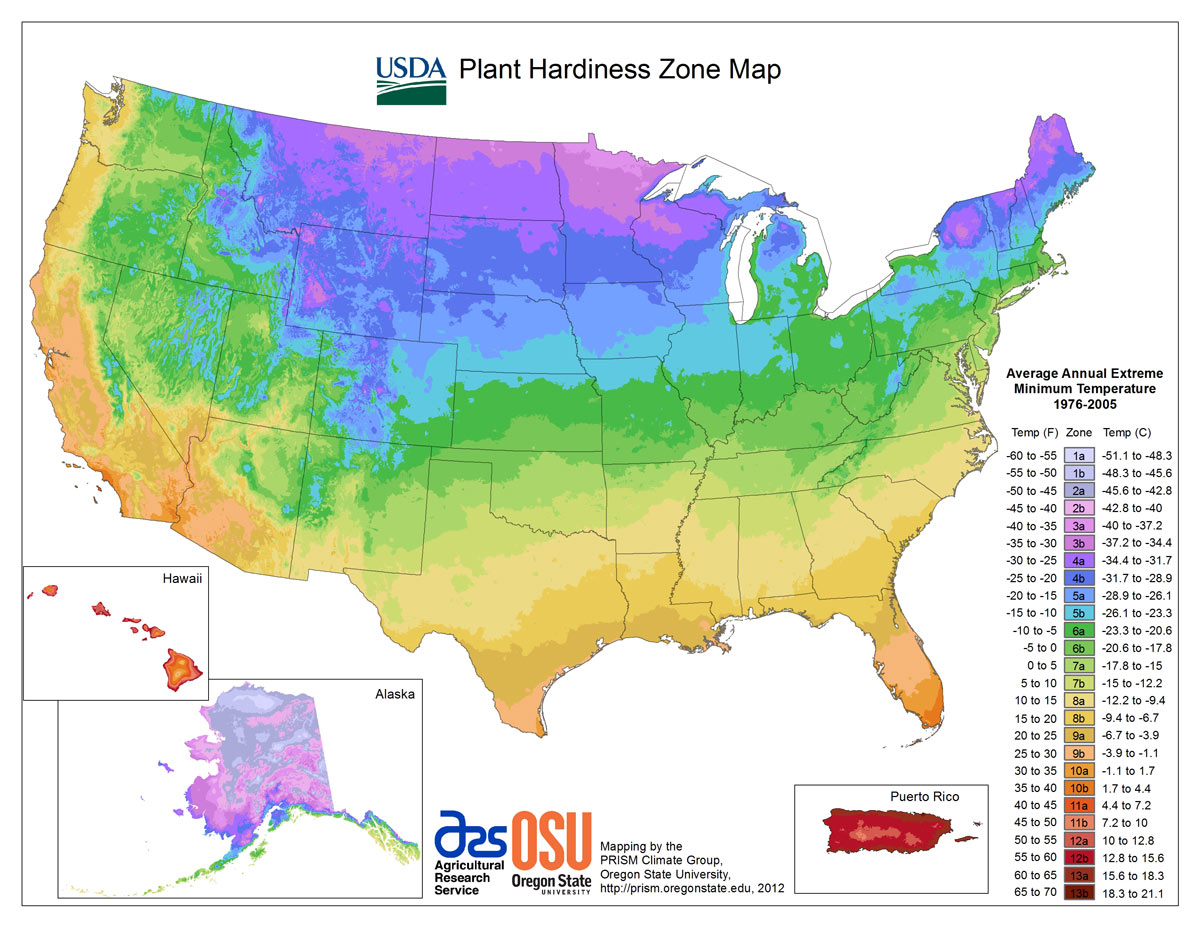HOW TO SELECT CORRECT HERBS FOR YOUR OUTDOOR HERB GARDEN
based on the system of plant hardiness zones
Have you ever heard or read about hardiness zones for plants and herbs but you don’t really get it?
Then this article may be for you. I will show you how to make a correct herb selection for the outdoor herb garden based on hardiness zones.
I will explain :
- what hardiness zones are
- what this means for your herb garden
- how to utilize your hardiness zone
- how to solve problems herb gardeners face in winter
I live in Belgium which is in plant hardiness zone 8. Do you have an idea in what zone you live in?
And why is that important to know you may ask!
Plant hardiness zones explained
When you are growing plants outdoors, on the patio, terrace or in the garden, it is good to have a clear idea about the climate you live in.
Plant hardiness zone 8 means that, according to the USDA (US department of Agriculture), on average the minimum temperature of my zone, during winter, drops to -12.2 °C (10 °F). This also means that my outdoor plants and herbs have to be capable of surviving this minimum temperature of −12.2 °C (10 °F).
If they can’t resist (if they aren’t hardy enough), they will die.
When you are keeping plants and herbs outdoors, a correct selection of plants suited to your climate is a key step to successful gardening. The colder your climate, the more your plants run the risk of not surviving the winter outdoors.
The Department of Agriculture (USDA) of the United States has started developing plant hardiness zone maps to aid gardeners and landscapers, in the beginning for the USA and later for the rest of the world.
Gardeners need a way to compare their own garden climates with the climate their plant is known to grow well in and these zone maps help them to do this.
These maps are based on the minimum ten-year average winter temperatures and represent a region of minimum average winter temperatures.
The lower the zone number, the colder the region.
The zone map divides the world or the continent into separate plant hardy zones. Each plant hardy zone is 10 degrees °F warmer (or colder) in an average winter than the adjacent zone.
The hardiness zones are divided into 13 zones (11 zones in Europe), which differ by 10 degrees Fahrenheit, ranging from -51 °C (-60 °F) to 21°C (70 °F).
What does this mean for us gardeners?
These zones provide us gardeners the coldest average temperatures for our garden location. In other words, it gives us an indication of what plants we can grow in our garden based on the average of lowest temperatures in our area.
You can find your hardiness zone here: https://www.plantmaps.com/index.php
Although a good guide for many gardeners, the USDA zone map is not perfect. Remember these maps work with averages, so temperatures CAN go under what is stated on the map.
And you must have noticed that only temperature is factored in and not the rainfall, snowfall, elevation, wind or humidity.
This simply means that every location may have specific characteristics that still do or doesn’t allow plants to grow despite the hardiness zone, eg. microclimates,…
How to apply the hardiness zones
So if you are planning to plant a shrub, a perennial herb or plant, you need to make sure that this new plant will tolerate the winter temperature conditions in your area. In areas with frost, these hardy herbs grow as perennials, going dormant in the winter and coming back with new growth in the spring.
You do this by comparing the hardiness zone of your plant with the hardiness zone of your area. Where do you find the hardiness of plants?
Very often you can find it on the back of many seed packs (or see my list below)
Now back to our amazing herb garden. What perennial herbs survive in the different hardiness zones?
I’ve put together a list of perennial herbs and their respective hardiness zones:
| Zone 3 | From -40 °C to -34 °C From -40 °F to -30 °F | Catnip Chives |
| Zone 4 | From -34 °C to -28 °C From -30 °F to -20 °F | Mint |
| Zone 5 | From -28 °C to -23 °C From -20 °F to -10 °F | Thyme Lemon Balm Oregano Sage Angelica |
| Zone 6 | From -23 °C to -17 °C From -10 °F to 0 °F | Parsley Lavender |
| Zone 7 | From -17 °C to -12 °C From 0 °F to 10 °F | Marjoram |
| Zone 8 | From -12 °C to -6 °C From 10 °F to 20 °F | Bay Laurel Rosemary Lemon verbena |
How to solve problems gardeners face in winter
Don’t forget that we are talking about perennial plants, not annuals. Annuals set seed and die over the course of a single season, so winter conditions aren’t typically a factor.
If you absolutely want to grow a herb that doesn’t fit your hardiness zone, you will have to grow it in a container and bring it indoors in winter. This actually works for many herbs.
You can also try to protect the herb plant. Most herbs benefit from a layer of mulch (pine straw, coco bean hulls, hardwood bark) during the growing season. Mulch is an adequate winter protection for herbs such as mint and chives providing protection to minus 20°F. A winter mulch helps maintain uniform temperatures around the root system and provides protection against freezing.
Harsh, drying winds can prove as fatal as cold temperatures to some of the less cold tolerant herbs. The more cold-sensitive herbs have a better chance of survival if grown in a protected location.
So think twice if you live in cold areas. It is clear that a palm tree rated for zone 9 will not thrive in Zone 3. But it could very well be the case that a plant suited for zone 6 can still be grown in zone 5 with added winter protection.
If you want to keep your containers outside during winter and you won’t apply extra protection, some gardeners use another rule of thumb, lowering the zone by two, because plants in pots freeze earlier than in the open ground.
Now, let me know in the comments, what plant hardiness zone you live in?
Thanks
Join the community
If you are looking to grow an amazing herb garden, I strongly recommend signing up to our community and gain access to our FREE downloads and regular updates. We want to ensure your success by sharing our tips and tricks with you for growing herbs.
Leave us a comment
If, after reading the information above, you still have a question that remains unanswered, then let me know by mail or in the comments below.



